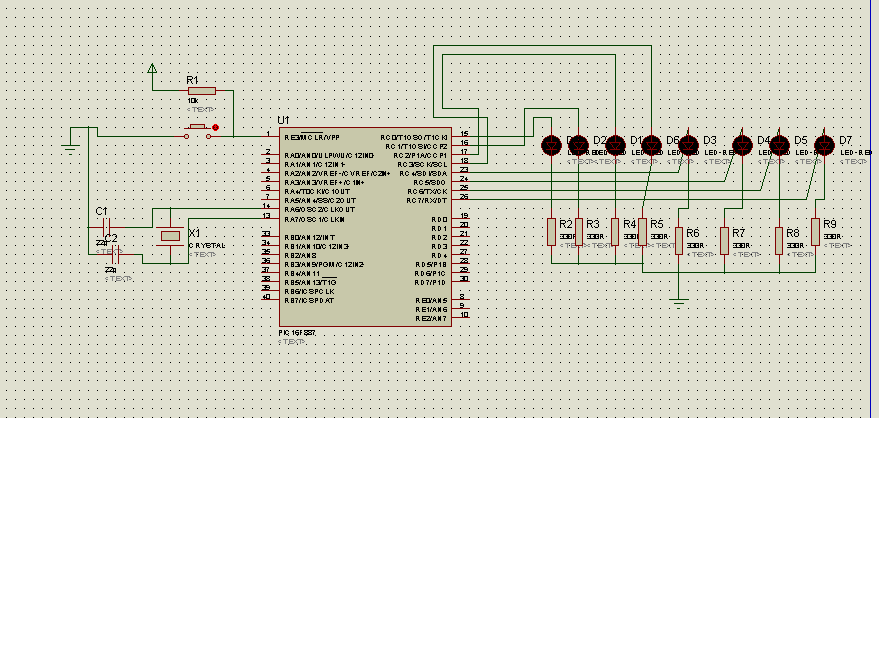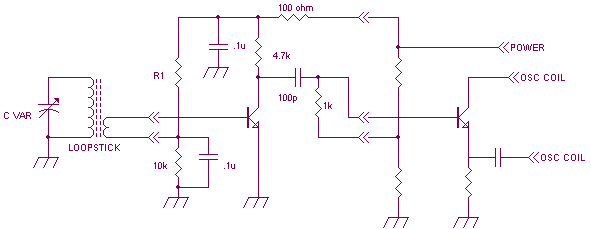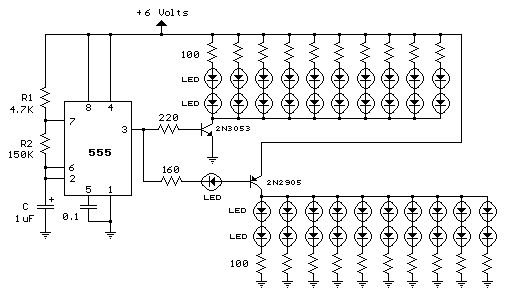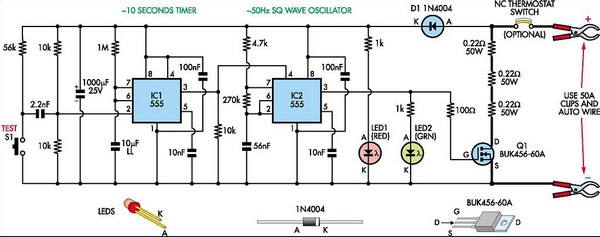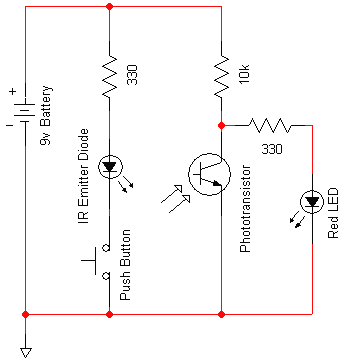
The Link 4+0 ?– Internal Intercoms

This version of the Link is intended for users who require an affordable and reliable intercom system without access to an external telephone line. It is suitable for environments such as preschools, hobby farms, or small workshops and factories, where external phone traffic needs to be isolated and protected from misuse by children. The design is based on the principles of the Link pulse dial circuit, with modifications and enhancements from the Link A2B+1 for DTMF dialing. The OSL relay and flip-flop (FF2) responsible for its activation and release have been removed, and two additional internal handsets with their corresponding relays and components have been added. FF1, part of the Ring Trip Circuit (RTC), remains in the schematic but is positioned at the bottom for clarity. The internal wiring for the RTR relay follows the Link A2B circuit. When any phone is taken off-hook and a number from 1 to 4 on the keypad is pressed, the DTMF decoder chip (IC2) decodes this input into IC3 (1 x 16 decoder). The output from IC3 is sent to the base resistors of Q1 to Q4 (R11 through R14). When pin 11 of IC3 goes low, it removes the high signal from pins 12 and 8 of IC1, initiating the impulsing of the selected line relay (LR1 to LR4) through driver transistor Q5 and the appropriate buffer transistor (Q1 to Q4). Once the called party answers, the RTC circuit interrupts the ring current, stopping the ringing tone and allowing the conversation to commence. After both parties hang up, the collector of OC1’s phototransistor goes high, resetting both FF1 and IC3. Pin 11 of IC3 returns high, ceasing the impulsing action of IC1 while providing a dial tone from pin 5 in the reset state, preparing for the next call. An additional feature involves the # output (pin 14 of IC3). Connecting this to the set (S) input of FF1 allows the ringer to be silenced if a call comes in while the user is away. The user can answer from another extension by pressing the # key, stopping the ringing and ensuring the ring tone does not disrupt ongoing conversations. This design closely mirrors the features of the Link pulse dialing version, with only a two-wire circuit connecting each handset to the central switcher. Tone dialing proves to be more efficient, and the unused outputs of IC3 can be repurposed for remote control applications, such as activating sprinklers, low-voltage garden lights, or door entry systems.
The intercom circuit utilizes a straightforward architecture that integrates several essential components for effective communication. The DTMF decoder (IC2) plays a critical role in interpreting the input signals from the keypad, translating them into binary outputs for further processing. The 1 x 16 decoder (IC3) is pivotal in managing the routing of calls to the appropriate line relays (LR1 to LR4), ensuring that each handset can connect to the intended party. The driver transistor (Q5) amplifies the control signals, enabling the line relays to engage properly and facilitate the communication link.
The Ring Trip Circuit (RTC), incorporating flip-flop FF1, is designed to manage the ringing signal and ensure that it is only active when necessary. The phototransistor in the collector of OC1 serves as a feedback mechanism, allowing the system to reset after a call is completed. This design minimizes the risk of false triggering and enhances the reliability of the intercom system.
The inclusion of additional features, such as the ability to silence the ringer with the # key, adds significant user convenience, making the intercom system more versatile. The potential for repurposing unused outputs from IC3 for other applications further enhances the overall functionality of the system, allowing users to integrate it into various environments seamlessly. This intercom design exemplifies a practical solution for communication needs in settings where external phone lines are not viable.This version of the Link is for those who really need a good cheap intercom that will work reliably, but without access to an outside Telco line. This could be in a pre school, a hobby farm or a small workshop or factory, where external phone traffic needs to be kept separate and protected from phone abusers and kids playing around … It follows ma
inly the principals of the Link pulse dial circuit, but with the modifications and additions of the Link A2B+1 for DTMF dialing. Basically what I ’ve done is remove the OSL relay and the flip flop (FF2) that controlled its activation and release, and added an extra two internal handsets and their associated relays and components.
FF1 (as part of the Ring Trip Circuit or RTC) is still there, but is now shown down the bottom of the diagram for simplicity ’s sake. Internal wiring for the RTR relay is as per the Link A2B circuit. When any phone is picked up off hook and a number from 1 to 4 on the keypad is pressed, the DTMF decoder chip (IC2) decodes this into IC3 (1 x 16 decoder) and the output of IC3 is then fed to the appropriate base resistor of Q1 to Q4 (R11 through R14).
Pin 11 of IC3 goes low, removing the high from pins 12 and 8 of IC1 and impulsing of the selected line relay (LR1 to LR4) begins, via driver transistor Q5 and the appropriate buffer transistor (Q1 to Q4). When the called party answers the call, the RTC circuit ‘trips ’ the ring current, impulsing along with the ring tone is halted, and the conversation can proceed.
When the conversation is completed and both phones are hung up, the collector of OC1 ’s phototransistor goes high and resets both FF1 and IC3. Pin 11 of IC3 goes high again, halting the impulsing action of IC1 but providing dial tone from pin 5 in the reset state, ready for the next call.
One extra nifty little feature involves the # output (pin 14 of IC3). If you connect this to the set (S) input of FF1, you can halt the ringer if someone calls your extension while you ’re away. You can pick up another extension anywhere else and press the # key and effectively ‘pick up ’ the call.
This feature prevents the other phone from continuing to ring and also halts the ring tone from overpowering your conversation. In principal, it follows very closely the features of the Link pulse dialing version, except that there ’s only a two wire circuit between each handset and the ‘black box ’ switcher.
In reality, tone dialing is more efficient, and you could easily use some of the other unused outputs of IC3 for remote control purposes (turning on sprinklers or low voltage garden lights, door entry systems etc. ) 🔗 External reference
The intercom circuit utilizes a straightforward architecture that integrates several essential components for effective communication. The DTMF decoder (IC2) plays a critical role in interpreting the input signals from the keypad, translating them into binary outputs for further processing. The 1 x 16 decoder (IC3) is pivotal in managing the routing of calls to the appropriate line relays (LR1 to LR4), ensuring that each handset can connect to the intended party. The driver transistor (Q5) amplifies the control signals, enabling the line relays to engage properly and facilitate the communication link.
The Ring Trip Circuit (RTC), incorporating flip-flop FF1, is designed to manage the ringing signal and ensure that it is only active when necessary. The phototransistor in the collector of OC1 serves as a feedback mechanism, allowing the system to reset after a call is completed. This design minimizes the risk of false triggering and enhances the reliability of the intercom system.
The inclusion of additional features, such as the ability to silence the ringer with the # key, adds significant user convenience, making the intercom system more versatile. The potential for repurposing unused outputs from IC3 for other applications further enhances the overall functionality of the system, allowing users to integrate it into various environments seamlessly. This intercom design exemplifies a practical solution for communication needs in settings where external phone lines are not viable.This version of the Link is for those who really need a good cheap intercom that will work reliably, but without access to an outside Telco line. This could be in a pre school, a hobby farm or a small workshop or factory, where external phone traffic needs to be kept separate and protected from phone abusers and kids playing around … It follows ma
inly the principals of the Link pulse dial circuit, but with the modifications and additions of the Link A2B+1 for DTMF dialing. Basically what I ’ve done is remove the OSL relay and the flip flop (FF2) that controlled its activation and release, and added an extra two internal handsets and their associated relays and components.
FF1 (as part of the Ring Trip Circuit or RTC) is still there, but is now shown down the bottom of the diagram for simplicity ’s sake. Internal wiring for the RTR relay is as per the Link A2B circuit. When any phone is picked up off hook and a number from 1 to 4 on the keypad is pressed, the DTMF decoder chip (IC2) decodes this into IC3 (1 x 16 decoder) and the output of IC3 is then fed to the appropriate base resistor of Q1 to Q4 (R11 through R14).
Pin 11 of IC3 goes low, removing the high from pins 12 and 8 of IC1 and impulsing of the selected line relay (LR1 to LR4) begins, via driver transistor Q5 and the appropriate buffer transistor (Q1 to Q4). When the called party answers the call, the RTC circuit ‘trips ’ the ring current, impulsing along with the ring tone is halted, and the conversation can proceed.
When the conversation is completed and both phones are hung up, the collector of OC1 ’s phototransistor goes high and resets both FF1 and IC3. Pin 11 of IC3 goes high again, halting the impulsing action of IC1 but providing dial tone from pin 5 in the reset state, ready for the next call.
One extra nifty little feature involves the # output (pin 14 of IC3). If you connect this to the set (S) input of FF1, you can halt the ringer if someone calls your extension while you ’re away. You can pick up another extension anywhere else and press the # key and effectively ‘pick up ’ the call.
This feature prevents the other phone from continuing to ring and also halts the ring tone from overpowering your conversation. In principal, it follows very closely the features of the Link pulse dialing version, except that there ’s only a two wire circuit between each handset and the ‘black box ’ switcher.
In reality, tone dialing is more efficient, and you could easily use some of the other unused outputs of IC3 for remote control purposes (turning on sprinklers or low voltage garden lights, door entry systems etc. ) 🔗 External reference
